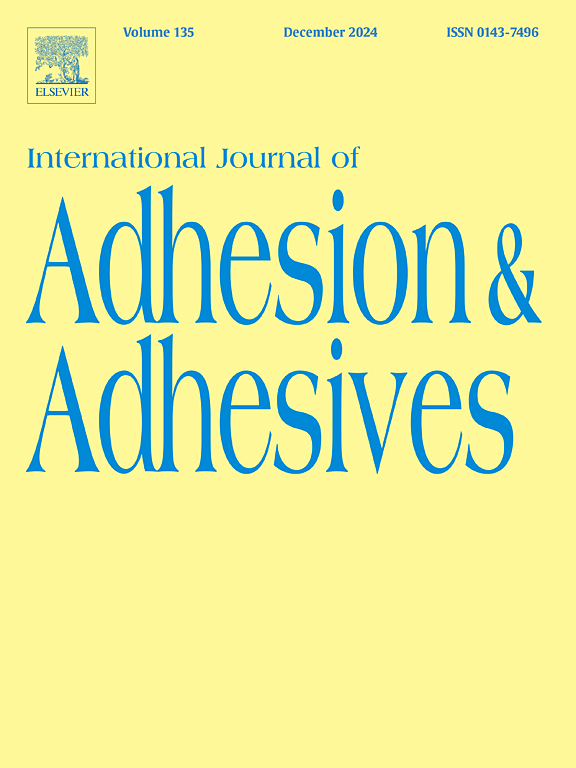A joint effort: Probabilistic methods for hybrid joint strength prediction
IF 3.5
3区 材料科学
Q2 ENGINEERING, CHEMICAL
International Journal of Adhesion and Adhesives
Pub Date : 2025-09-14
DOI:10.1016/j.ijadhadh.2025.104156
引用次数: 0
Abstract
This study investigates the strength prediction of hybrid joints that combine adhesive bonding with mechanical fasteners using probabilistic methods, focusing on four cold-curing adhesives: DP460, SW7240, SF479, and S370, which exhibit varying mechanical properties and performance outcomes; experimental results reveal that DP460 has the highest average joint strength at 329.4 ± 19.1 kN, while SF479 shows the lowest at 286.2 ± 42.7 kN, highlighting the significant influence of adhesive properties on load-bearing capacity. Previous studies had shown that the strength of hybrid joints was governed mainly by the adhesive's E-modulus, whereas bulk tensile strength dominated in single-lap bonded joints, indicating different failure mechanisms. A statistical analysis on the strength expressed in terms of hydrostatic pressure and maximum principal stress using Weibull distributions quantifies the variability in adhesive strength and predicts failure probabilities under non-uniform stress distributions, indicating that the bilinear failure criterion enhances prediction accuracy, particularly for adhesives like SW7240 and SF479, which demonstrate complex failure behaviours. Predictions versus experimental load capacities show that a linear failure criterion combined with a two-parameter Weibull distribution generally provides reasonable predictions with deviations of +1 % to +15 %, while the bilinear criterion can underestimate strengths for epoxies by up to 24 % and overestimate for elastoplastic materials like SF479. The study also addresses scatter in strength predictions, finding that the two-parameter Weibull distribution underestimates the lower bound (AVG – 1 × SD) by about 10 % and overestimates the upper bound (AVG + 1 × SD) by 18 %, with scatter analysis revealing that the probabilistic approach effectively captures variability in failure behaviour, despite challenges in maintaining consistent sample geometry and stress distributions, particularly in off-axis specimens. The study highlighted the need for accurate measurement of adhesive thickness and bolt pretension, showing that the probabilistic dimensioning method reliably predicted joint performance without empirical adjustments. It underscored the decisive role of adhesive properties and failure criteria, demonstrating that probabilistic methods improve load and failure predictions while supporting more reliable hybrid joint designs in engineering applications.
联合努力:混合接头强度预测的概率方法
本研究采用概率方法研究了胶粘剂与机械紧固件结合的混合接头的强度预测,重点研究了四种冷固化胶粘剂:DP460、SW7240、SF479和S370,这四种胶粘剂具有不同的力学性能和性能结果;实验结果表明,DP460的平均接头强度最高,为329.4±19.1 kN, SF479的平均接头强度最低,为286.2±42.7 kN,可见胶粘剂性能对承载能力的显著影响。以往的研究表明,混合接头的强度主要受胶粘剂e模量的影响,而单搭接接头的体抗拉强度则占主导地位,表明其破坏机制不同。用威布尔分布对以静水压力和最大主应力表示的强度进行统计分析,量化了胶粘剂强度的可变性,并预测了非均匀应力分布下的破坏概率,表明双线性破坏准则提高了预测精度,特别是对于SW7240和SF479等具有复杂破坏行为的胶粘剂。预测与实验载荷能力的对比表明,线性破坏准则结合双参数威布尔分布通常提供合理的预测,偏差为+ 1%至+ 15%,而双线性准则可能低估环氧树脂强度达24%,高估弹塑性材料如SF479。该研究还解决了强度预测中的散点问题,发现双参数威布尔分布低估了下界(AVG - 1 × SD)约10%,高估了上界(AVG + 1 × SD) 18%,散点分析表明,尽管在保持一致的样品几何形状和应力分布方面存在挑战,但概率方法有效地捕获了失效行为的变异性,特别是在离轴样品中。该研究强调了准确测量胶粘剂厚度和螺栓预紧力的必要性,表明概率量纲法可以可靠地预测接头性能,无需经验调整。它强调了胶粘剂性能和失效标准的决定性作用,表明概率方法可以改善载荷和失效预测,同时在工程应用中支持更可靠的混合接头设计。
本文章由计算机程序翻译,如有差异,请以英文原文为准。
求助全文
约1分钟内获得全文
求助全文
来源期刊

International Journal of Adhesion and Adhesives
工程技术-材料科学:综合
CiteScore
6.90
自引率
8.80%
发文量
200
审稿时长
8.3 months
期刊介绍:
The International Journal of Adhesion and Adhesives draws together the many aspects of the science and technology of adhesive materials, from fundamental research and development work to industrial applications. Subject areas covered include: interfacial interactions, surface chemistry, methods of testing, accumulation of test data on physical and mechanical properties, environmental effects, new adhesive materials, sealants, design of bonded joints, and manufacturing technology.
 求助内容:
求助内容: 应助结果提醒方式:
应助结果提醒方式:


